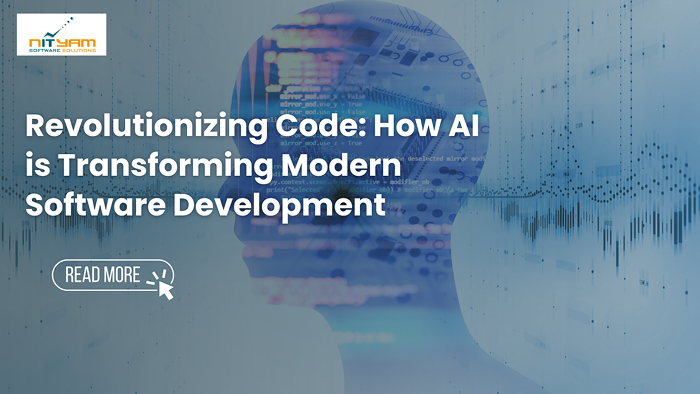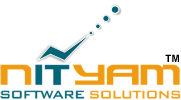
Revolutionizing Code: How AI is Transforming Modern Software Development.
Artificial intelligence (AI) is no longer a distant dream reserved for science fiction or futuristic predictions. Today, it is actively reshaping nearly every sector of industry, and software development is at the heart of this transformative wave. The way developers conceptualize, write, test, and refine code has changed more in the last decade than in the previous forty years combined. AI is the central catalyst in this shift, moving software engineering from a craft of manual logic to a fusion of human creativity and machine intelligence.
This article explores how AI is transforming coding and end-to-end software development. It reviews past practices, examines key AI technologies and tools, outlines benefits and challenges, and predicts future trends—highlighting why early adopters like Nityam Software Solutions gain a competitive edge in performance, scalability, and innovation.
The Evolution of Software Development Practices
To understand the role AI plays in today’s development landscape, we must first understand how far we’ve come. In earlier generations, development was painstakingly slow. The first programmers wrote in machine language—binary code instructions (0s and 1s)—that directly translated to operations on the CPU. Debugging and maintaining such code required intimate knowledge of microarchitectures, registers, and circuits.
The burden eased with assembly languages, offering mnemonic codes like MOV, JMP, or ADD. Assembly created a bridge between human cognition and machine execution, but programming was still technical and highly specific. A breakthrough came in the higher-level languages starting in the late 1950s
- Fortran (1957) provided scientific computation capabilities.
- COBOL (1959) became dominant for business and financial transaction systems.
- C (1972) introduced abstraction closer to natural design logic.
- Java (1995) emphasized portability through its “write once, run anywhere” philosophy.
Advancements accelerated with integrated development environments (IDEs) such as Eclipse, IntelliJ, and Visual Studio. These tools consolidated syntax highlighting, debugging, compiling, and project navigation under a single roof. Later, version control systems like Git and Subversion enabled collaborative contributions and rollback features across large teams, revolutionizing code management.
Cloud computing, spearheaded by AWS, Azure, and Google Cloud, opened a new dimension—applications could now scale elastically without concern for hardware infrastructure. Later, containers (Docker, Kubernetes) ensured development, test, and production configurations were uniform.
This cumulative journey—from binary coding to distributed cloud-native architectures—set the perfect stage for AI to step in and revolutionize software engineering itself.
Key AI Technologies Transforming Development
Artificial intelligence is both a spectrum of theories and a toolbox of practical technologies. Multiple subfields converge in software development applications:
Machine Learning (ML)
- Algorithms learn from example data without being explicitly programmed with rules. In software engineering
- ML-driven models can detect bugs by analyzing millions of historical codebases.
- Predictive models suggest optimal data structures or configurations for given requirements.
- Automated code generators use learned statistical patterns to output functional code snippets.
Computer Vision
- On the surface, vision seems unrelated to coding, but GUI-heavy software systems often rely on visual-level quality assurance.
- Vision models simulate user interactions with front-end interfaces (e.g., identifying broken element layouts).
- They evaluate accessibility standards such as color contrast compliance for visually impaired audiences.
Reinforcement Learning (RL)
- RL is ideal for optimization problems:
- Compile-time optimizations can be improved by agents that test different strategies under simulated reward feedback.
- AI learns which arrangement of microservices improves latency or resource utilization.
Generative AI
The generative branch of AI, including large language models (LLMs) like GPT, is fueling the rise of intelligent code generation at scale. From frameworks like GitHub Copilot to specialized enterprise-level internal assistants, generative AI converts high-level intent into high-fidelity code.
Benefits of AI Integration in Software Development
The integration of AI into development workflows creates economic, technical, and cultural benefits.
Automation of Repetitive Tasks
Boring, repetitive coding tasks are a psychology drain on developers. AI removes this burden:
- Template code generation saves time.
- Automated testing scripts minimize manual quality assurance.
- Code refactoring tasks are delegated to efficient ML-guided agents.
Increased Code Accuracy and Safety
- Defects cost billions annually. AI reduces failure probability by:
- Spotting vulnerabilities before deployment.
- Ensuring compliance with secure coding practices.
- Checking for potential memory leaks, dependency mismatches, or race conditions.
Enhanced Productivity and Creativity
Instead of focusing on “plumbing code,” developers engage in design thinking and creative innovation, leveraging AI to handle routine grounding tasks. Creativity flourishes when repetitive resistance barriers are eliminated.
Improved Team Collaboration
AI systems analyze project repositories to detect overlapping work, suggest modularization, and provide real-time insights about conflicts. Knowledge transfer becomes smoother since AI can “document” developer logic for new hires.
AI in Software Testing
Perhaps the most disruptive arena is QA (quality assurance). AI:
- Creates synthetic test datasets to cover edge cases.
- Prioritizes tests according to probability of bug discovery.
- Continuously executes tests through CI/CD pipelines.
- Simulates various load and failure conditions automatically.
- The gains include reduced development cycles, higher application reliability, and lower long-term operational costs.
Challenges and Limitations
Despite incredible progress, AI in programming introduces challenges:
- Data Bias: AI models trained on biased repositories may suggest insecure or outdated practices.
- Interpretability: Developers must trust black-box predictions they cannot fully understand.
- Ethical Implications: Questions of accountability for AI-generated code when something breaks.
- Dependence Risk: Over-reliance may deskill the human coding workforce in the long run.
These challenges demand robust governance frameworks to balance adoption with safety.
Future Trends in AI and Software Engineering
The road ahead points to even deeper AI integration.
- AI-supercharged IDEs: Universal copilots for every developer task—coding, debugging, documenting, and deploying.
- Fully Autonomous Low-Code Platforms: AI will empower business managers with minimal coding knowledge to build robust applications.
- Quantum-AI Development Collision: In 10–15 years, AI-coded quantum programs may unlock problems classic systems cannot solve.
- Ethics-Driven AI Governance in Development: Enterprises will adopt strict frameworks to prevent bias, plagiarism, and security vulnerabilities from AI models.
Soon, developer + AI pairs will become the expected standard. AI will not replace developers—it will evolve what it means to be one.
Conclusion: AI as a Partner in Development—and Why Nityam Software Solutions Is Leading This Shift
Artificial intelligence has fundamentally altered how software is designed, written, and maintained. From historical progress out of binary code to the emerging symbiosis of humans and machines, each transformation enhances efficiency, creativity, collaboration, and innovation.
Yet AI should never be viewed as a replacement for human ingenuity. Instead, it acts as a creative partner: handling repetitive groundwork while humans focus on problem-solving, vision, and impactful application design. Companies that recognize this balance will outpace their competitors.
This is where Nityam Software Solutions comes in. As a forward-thinking digital solutions provider, Nityam is actively aligning with AI-driven development paradigms—whether in advanced SaaS product engineering, optimized DevOps pipelines, or intelligent automation solutions. By embedding AI into every stage of the software lifecycle, Nityam empowers teams and clients to achieve higher code quality, faster deployments, and future-ready applications.
In the next decade, successful enterprises will be defined by their ability to embrace AI as a collaborator rather than just a tool. Nityam Software Solutions exemplifies this spirit today—pioneering not only efficiency gains but also reimagining what is possible when human creativity joins forces with machine intelligence.
The journey of revolutionizing code through AI has only just begun. And as organizations like Nityam demonstrate, its potential is truly limitless.



Pradnya Ghorpade
Very Informative blog